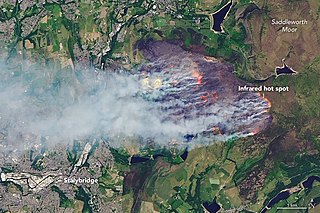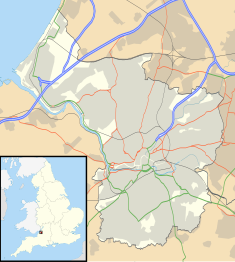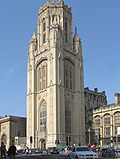
The University of Bristol is a red brick Russell Group research university in Bristol, England. It received its royal charter in 1909, although it can trace its roots to a Merchant Venturers' school founded in 1595 and University College, Bristol, which had been in existence since 1876.

Sir Michael Victor Berry,, is a mathematical physicist at the University of Bristol, England.

Keynsham is a town and civil parish located between Bristol and Bath in Somerset, England. It had a population of 19,603 at the 2021 Census. It was listed in the Domesday Book as Cainesham, which is believed to mean the home of Saint Keyne.

Cotham is an area of Bristol, England, about 1 mile north of the city centre. It is an affluent, leafy, inner city suburb situated north of the neighbourhoods of Kingsdown and St Paul’s and sandwiched between Gloucester Road (A38) to the east, and Hampton Road to the west.

University College, Bristol was an educational institution which existed from 1876 to 1909. It was the predecessor institution to the University of Bristol, which gained a royal charter in 1909. During its time the college mainly served the middle classes of Bristol, and catered for young men who had entered a family business and needed a greater understanding of scientific topics.

The Wills Memorial Building is a neo-Gothic building in Bristol, England, designed by Sir George Oatley and built as a memorial to Henry Overton Wills III by his sons George and Henry Wills. Begun in 1915 and not opened until 1925, it is considered one of the last great Gothic buildings to be built in England.

Wills Hall is one of more than twenty halls of residence in the University of Bristol. It is located high on the Stoke Bishop site on the edge of the Bristol Downs, and houses c. 370 students in two quadrangles. Almost all of these students are in their first year of study.

Stoke Bishop is a medium-sized outer city suburb in the north-west of Bristol, located in between Westbury-on-Trym, Sneyd Park, and Sea Mills. Although relatively low, Stoke Bishop's population has increased due to substantial infilling on the Smelting Works sports ground and The Grove which used to belong to Clifton High school. The population of Stoke Bishop varies throughout the year because of the influx of students to the large campus of Bristol University halls of residence situated on the edge of the suburb and the Downs during term time.
Sir George Herbert Oatley was an English architect noted for his work in Bristol, especially the gothic Wills Memorial Building. He was knighted for public service in 1925.

The Grand Pier is a pleasure pier in Weston-super-Mare, North Somerset, situated on the Bristol Channel approximately 18 miles (29 km) southwest of Bristol. It opened in 1904 and has been Listed Grade II since 1983. It is 366 metres (1,201 ft) long.

Avon Fire & Rescue Service (AF&RS) is the fire and rescue service covering the unitary authorities of Bath and North East Somerset, Bristol, North Somerset, and South Gloucestershire in South West England.

The West Yorkshire Fire and Rescue Service (WYFRS) is the county-wide, statutory emergency fire and rescue service for the metropolitan county of West Yorkshire, England. It is administered by a joint authority of 22 people who are appointed annually from the five metropolitan boroughs of West Yorkshire, known as the Fire and Rescue Authority.
Bristol is the largest city in South West England, and as such is a centre for culture, research and higher education in the region. The city is home to a prestigious "red brick university" and a high-ranking "new university". The city is also noted for its investment in the sciences and engineering, particularly its ties to the aerospace industry.

The Mount Without was a church now a creative space on St Michael's Hill in Bristol, England, near the University. It has been designated as a grade II* listed building, and was described as being in poor condition and on the Buildings at Risk Register.
Halls of residence at the University of Bristol are generally located within three distinct areas of Bristol, the City Centre, Clifton and Stoke Bishop.
The history of the University of Bristol can be said to have begun in 1909 when the university gained a royal charter which allowed it to award degrees. Like most English universities, Bristol evolved from earlier institutions, most notably University College, Bristol, Bristol Medical School (1833) and the Merchant Venturers' Technical College (founded as a school 1595 and which became the university engineering faculty.

Starting on 24 June 2018 and continuing throughout the summer, a record-breaking series of wildfires burned across the United Kingdom. The two largest fires, which were declared major incidents, burned over 7 square miles each and broke out on Saddleworth Moor in Greater Manchester and Winter Hill in Lancashire. Other large fires broke out in Glenshane Pass in County Londonderry, Northern Ireland, Epping Forest, in London and in the Vale of Rheidol in Ceredigion, Wales. The Saddleworth Moor fire has been described as the largest English wildfire in living memory. Most of the wildfires occurred during the first official heatwave in the United Kingdom since June 2017, with temperatures reaching above 30 °C (86 °F) for several days, making the hottest June in the country since 1995, and the driest June for over ten years in large parts of the United Kingdom, exacerbating the crisis. A wildfire started on the Staffordshire Moorlands on 9 August and, despite rain, had spread to cover 219 acres by 11 August. Some hot spots were still burning as at 22 August. In total, there were 79 fires over the course of the year, a new record. However, the record was beaten in 2019 with 96 fires as of April 23.

Bristol Guildhall is a municipal building in Broad Street, Bristol, England. It is a Grade II* listed building. It was built in the 1840s on the site of the previous guildhall and used as a courthouse from the 1860s to 1993. Various plans for its use as an art gallery and hotel were then proposed. In March 2020 it was damaged by a fire which led to its roof collapsing.

Burnham Pier is a pleasure pier in Burnham-on-Sea in Somerset, England. Built in 1914, it measures 37 metres (121 ft) in length and has been described as the shortest pier in the United Kingdom. At low tide the pier is up to 1.5 miles (2.4 km) from the sea.

















